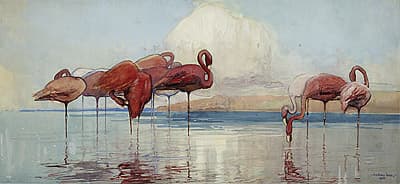
Sydney
LONG
Australia
1871
–
London
1955
England, Europe 1910-21; Australia 1921- 22; England 1922-25; Australia 1925-52; England from 1952
36.0 (h) x 76.2 (w) cm
signed and dated ‘SYDNEY LONG/ 1920’ lower right private collection
Between 1902 and 1940 Long painted over 30 images of this very popular subject. His Art Nouveau approach was ideally suited to the depiction of the flamingo, whose appearance seems almost unnatural – it is too vivid in colour and peculiar in shape, with a long, flexible neck and rotund body perched on thin legs. But, the flamboyance of the flamingo, its sinuous neck, its propensity to bend and bow made it an ideal subject for Long’s decorative compositions.
The mythical quality of the flamingo, including a similarity to the phoenix, the immortal bird that was consumed by flames and then rose from the ashes, gives Long’s images of flamingoes an added resonance.
Here Long depicted the flamingoes with a pinker plumage than in his first version of the subject in 1902 (cat 18), and located them in an open lake, creating a harmony of pink and blue. He placed a large cumulus cloud in the sky, which forms a decorative counterpoint to the round bodies of the birds.
Between 1902 and 1940 Long painted over 30 images of this very popular subject. His Art Nouveau approach was ideally suited to the depiction of the flamingo, whose appearance seems almost unnatural – it is too vivid in colour and peculiar in shape, with a long, flexible neck and rotund body perched on thin legs. But, the flamboyance of the flamingo, its sinuous neck, its propensity to bend and bow made it an ideal subject for Long’s decorative compositions.
The mythical quality of the flamingo, including a similarity to the phoenix, the immortal bird that was consumed by flames and then rose from the ashes, gives Long’s images of flamingoes an added resonance.
Here Long depicted the flamingoes with a pinker plumage than in his first version of the subject in 1902 (cat 18), and located them in an open lake, creating a harmony of pink and blue. He placed a large cumulus cloud in the sky, which forms a decorative counterpoint to the round bodies of the birds.
Between 1902 and 1940 Long painted over 30 images of this very popular subject. His Art Nouveau approach was ideally suited to the depiction of the flamingo, whose appearance seems almost unnatural – it is too vivid in colour and peculiar in shape, with a long, flexible neck and rotund body perched on thin legs. But, the flamboyance of the flamingo, its sinuous neck, its propensity to bend and bow made it an ideal subject for Long’s decorative compositions.
The mythical quality of the flamingo, including a similarity to the phoenix, the immortal bird that was consumed by flames and then rose from the ashes, gives Long’s images of flamingoes an added resonance.
Here Long depicted the flamingoes with a pinker plumage than in his first version of the subject in 1902 (cat 18), and located them in an open lake, creating a harmony of pink and blue. He placed a large cumulus cloud in the sky, which forms a decorative counterpoint to the round bodies of the birds.
